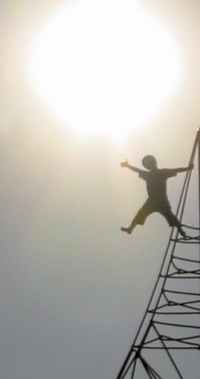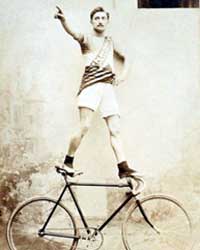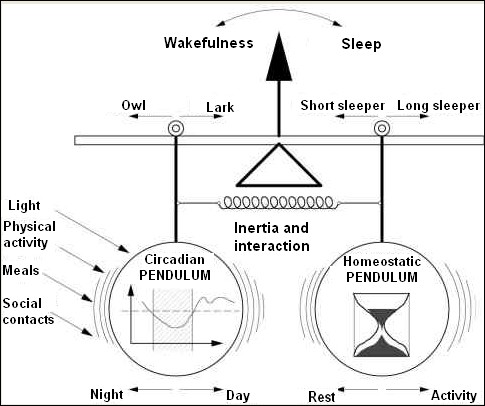Home > Welcome > Sleep-wake pathologies > Insomnia - wanting to sleep > The somnications
The somnications
Monday 30 July 2007
All the versions of this article: [English] [français] [română]
The quality and the depth of sleep depend in fact on the quality of wakefulness.
The "somnications (the natural medications of sleep) are the nap, the light, the heat, and pleasure.

- Phototherapy...
One can easily get hold of them through sport, all sorts of passions, social contacts, laughter and love.
Here is some advices to help reinforce the performances of the sleeper: Be careful, the short sleeping subjects risk to sleep even less !
"Sleep better, sleep little, live better"
It is striking to observe that the "sleeping pills" induce exactly the opposite... they lighten the sleep and thus, in the beginning, extend it artificially. The person who "wants to" sleep thinks he/she is satisfied, but, no matter the kind of "miracle drug", that way of thinking is "somnotoxic" and leads to the cognitive and behavioral vicious circle of insomnia.
Our "internal clock" is set daily by "time givers" which are elements that are able to change the period (the movement) of each of the pendulums.
"Somnications". There are four of them. The nap, the light, the heat, and pleasure.
Their combinations, like in outdoors exercise (heat, light, pleasure and contacts), going out with the family, or militant associations for example, offer numerous opportunities to potentialize their effects.
- The nap is the keystone of the sleep-wake balance.:

- The sun is a somnication
- The light :
- It has been shown that the exposure to a light source of sufficient intensity exerts an arousing effect that can be compared to coffee, for example. In this example, the light has an influence on the pendulum that regulates homeostasis (the "H Hourglass") by allowing to prolonge the arousal (in a way).
- The light also exerts an influence as a time giver (Zeitgeber) on the pendulum of the circadian regulation ("the cerebral clock"). That influence is of a "phase response" type, around the point when the body temperature is lowest (at 3 or 4 AM).
The light blocks out the secretion of melatonin, thus there is no or very little secretion of melatonin during the day. On the opposite, the secretion of that hormone is highest during the night (with a peak around 3 AM). - Sport:

- The practice of a sport of endurance
"Sport : is good for sleep ..."
Our grandmas were right.
The regular practice of a physical activity of endurance is one of the keys of the treatment of fatigue and insomnia.
As for the light, the (moderate) physical exercise has shown a directly arousing effect (that is the reason why the service areas of the highway have that kind of facilities).
The simple fact of getting out of the car and walk a couple of steps is more immediately efficient against sleepiness than the coffee that one drinks at that occasion(because the time it takes to act is very long).
Yet, sleepiness behind the wheel requires the practice of an "emergency nap" which is the only way to restore the optimal condition on a long-term basis (Read about "excessive daytime sleepiness").Sport combined to light :
It has also been proven that the practice of an exercise bike, in a phototherapy cabin taken on board of long haul trucks, allows to divide the number of accidents in two, with the same number of breaks. - The heat :
It has been demonstrated that the body temperature has a great influence on the rythms of vigilance.
The effect of sport (practiced around 6 PM) on the slow waves of sleep is inhibited by the intake of medications (like paracetamol, a.o.) which thwart the thermic ascent. It is thus directly the heat that is produced by the effort that has an effect on sleep.
Apart from sport, warm spa bath therapy, sauna, hammam and sunbathing are therefore elements that favor the diurnal thermic ascent and the production of slow wave during sleep.That chronobiological effect can be taken advantage from in the context of the caretaking of tiredness.
Nb. In our opinion, a possible physiopathological explanation of the "premenstrual syndrome".
That syndrome, from which some women suffer short before menstruation, combines a loss of tone, painful functional disorders and mood and character disorders.
To our minds, its origin can be rather linked to a decrease in sleep efficiency (in relation with the changes of body temperature linked to the hormonal disturbances) than to the influence of the moon or the chromosome "Y". - And pleasure ...
"The cheerful always recover." (Rabelais)Unlike what may seem, pleasure is not the most simple somnication to get .
One must (at least) be able to avoid to "force" against oneself. As a general rule, subjects who suffer of tiredness and functional disorders are not able to give themselves the "opportunity" of taking time to enjoy themselves.All free-time activities and passions are propitious to sleep because the time that is devoted to them often leads to reducing the time that is devoted to sleep.
Be careful. The property of pleasure to compress sleep must not, even so, create "Excessive daytime sleepiness" like it is the case for 10 to 20 % of our contemporaries.
Young people can, because they are unaware of the limits of their abilities to resist, turn over to a state of hyperarousal borderline to pathological hypomania.
It is often at the occasion of a chronobiological decompensation (inversion of the day/night cycle) that serious sleep disorders like primary insomnia or false hypersomnia begin."The more the teenager is in love, the less he/she sleeps"
The authors of study about sleep at that age of life conclude :
A recent study of the Swiss psychiatrist Serge Brand, published in the Journal of Adolescent Health, has observed the sleep of teenagers in love and shows very clearly the effect of the somnication "pleasure" on sleep that becomes shorter and more efficient.
"Consequently, to not bias data in research with adolescents, current stage of love should be taken into account". Ref (Romantic Love, Hypomania and Sleep Pattern in Adolescents, juil07)
Nb. "Man is the only animal that takes on his sleeptime to reproduce himself" said Cavanna, the French writer and humorist.
That aphorism suggests that one sometimes must be able to choose... - A couple of words about social contacts.
The rythm of the meals, or other group activities, is a determining synchronizer in man. The more we are submitted to a regular group activity, the more our internal clocks become synchronized. Particular rythms (like menstruation) can be completely induced by the life in a group. Women who live together often experience that their menstruation occur at a similar time after a while.The cohesion of the group plays a very important role with its action on the rythms : it can be seen in military, sportive, religious environments, in some groups of students...
The synchronization of the rythms increases in proportion with the physical activity. Beware, though, of very physical activities in the evening (sport, nightclubbing...) because they have the same effect as a strong light : they delay sleep the following days.
The nap is "a powerful double edged weapon that must be handled with care".
See the general public leaflet : Everything that should be learned since school...
See the RGP sheet, the summary designed for the health professionals . "Ask your doctor or pharmacist’s opinion".
The sun is a somnication.
Take advantage, whenever it is possible of the sun from the morning on (avoid to sleep in) and, during the day, avoid to have a nap.
To act, the light must have a quite strong intensity ( ± 2 500 lux), much higher than that obtained in a flat or an office. The lighting of a room is rarely higher than 250 lux, whereas the outdoors luminosity is between 2 000 à 100 000 lux.
The therapy with light by means of medical lamps has proven its efficiency.
In the case of a delayed phase, wearing sunglasses at the end of the day is advocated.
The light has another effect on the quality of wakefulness which is not linked to melatonin,
A very late exposure to light, until 4 AM (in order to prepare a journey to the West Indies, for example), delays the hour of sleep onset and getting up the next days.
The scheduling of a very early rise, combined to phototherapy and to sport in the early morning, as well as the wear of filtering glasses at the end of the day, allows on the opposite to gradually advance the bedtime hour and fight against phase delay (of the sleeper who is unable to sleep before 4 AM)
Nb. To the contrary, nightworkers are advised to wear "chromotherapy" glasses especially studied to filter particular frequencies of light and avoid, that way, to stimulate arousal when the person is back home.

- More information...
- 30 minutes d’exercice pour se remonter le moral (Chaussures de marche versus médicaments antidepresseurs...)
- Effects of Acute Exercise on Mood and Well-Being in Patients with Major Depressive Disorder (12/29/2005, John B. Bartholomew; David Morrison; Joseph T. Ciccolo)
- Webscience (Romantic love, hypomania, and sleep pattern in adolescents, J Adolesc Health 2007;41(1):69-76.).
